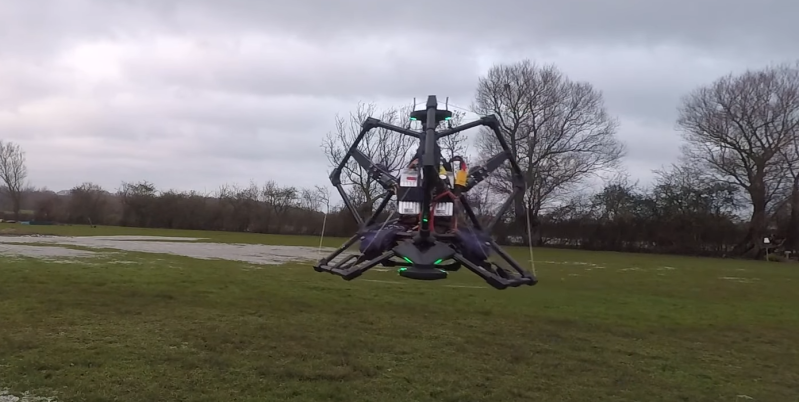Modern multirotors are very maneuverable but are mostly limited to hovering in a single orientation. [Peter Hall] has gotten around this by building an omnicopter drone with six motors mounted in different orientations on a collapsed tetrahedron frame.
 The shape of the frame consists of six tetrahedrons all joined together at a single point. With a motor in each frame, the drone can produce a thrust vector in any direction, to achieve six degrees of freedom. The control system is the challenging part of this project, but fortunately [Peter] is one of the Ardupilot developers. Unlike a standard multirotor, it doesn’t need to tilt to move around laterally but can keep its orientation constant. One of the limiting factors is that the motors need to stop and reverse rotation for direction changes, which takes time. At slow maneuvering speeds this isn’t a major problem, but at higher speeds rotation is noticeably less smooth.
The shape of the frame consists of six tetrahedrons all joined together at a single point. With a motor in each frame, the drone can produce a thrust vector in any direction, to achieve six degrees of freedom. The control system is the challenging part of this project, but fortunately [Peter] is one of the Ardupilot developers. Unlike a standard multirotor, it doesn’t need to tilt to move around laterally but can keep its orientation constant. One of the limiting factors is that the motors need to stop and reverse rotation for direction changes, which takes time. At slow maneuvering speeds this isn’t a major problem, but at higher speeds rotation is noticeably less smooth.
Because the drone is symmetrical all around, keeping track of orientation is challenging for a human pilot, but it’s perfect for an autopilot system like Ardupilot. In the video after the break, [Peter] demonstrates this by flying the drone around while the autopilot rotates it randomly. The 6DoF control system is open source and a pull request is live to integrate it into the official version of Ardupilot. The obvious application for this sort of drone is for inspection in and around structures.
This omnicopter is an entry into the Lynchpin drone competition by the celebrity [Terrence Howard]. We’re not quite following his claims regarding the scientific significance of this shape, which he named the “Lynchpin”, but it works for drones.
Earlier in the year [Peter] demonstrated indoor motion tracking for drones with SteamVR hardware. It is not the first 6 DoF omnicopter we’ve seen, but it is the simplest. Another version by ETH Zurich requires eight motors
Thanks for the tip [Matt Kear]!















Incredible work. I’m loving all these proof of concept aircraft builds that people are doing lately. I think the high thrust to weight ratio of the racing drone components has a lot to do with it; enables things to fly even if the aerodynamics are not very efficient. Not to detract from the results at all, it really is amazing to watch.
Also.. imagine this thing with no prop guards. It would be a tornado of spinning props, awesome :)
I think the current term is “Biblically accurate”.
(From “Biblically accurate angels”, which are terrifying vortices of wings and eyes, rather than people with wings and halos.)
love it, to bad here in the good old free us of a you will soon land yourself in hot water for making such a craft thanks to the upcoming regulations :(
Which regulations won’t allow you to build a novel drone design like this one? I’m not trolling, I legitimately want to know because I didn’t think anything like that was in the pipeline.
The sky is falling because you might have to have a beacon on it.
not just remote ID but if you look at who was appointed to the panel who gets to make decisions on future of flying. I’ll give you 3 guesses and if any of them are any advocates for the hobby you are wrong. They are all alphabet companies and big business. remote ID is only onel step in regulating a hobby out of existence. If you want further proof go here https://www.faa.gov/uas/programs_partnerships/drone_advisory_committee/ look at the membership (pdf form) and find one person on there that is pro hobby.
Just keep it under 250g, very possibly, though it’ll be at least 1/2 the size. Have a baby yoda w/OF, baro, fpv camera and even hides the props at 238g with ~5min flight time.
Yes the power to weight of 0802/2205 motors are pretty awesome. Amp draw is phenomenal.
Great work, creative thinking is A+, though not a fan of omnicopters (too inefficient inlet flow dynamics/limitations), but nonetheless cool.
luckily it’s easier to apologize than ask permission when we’re talking about a craft weighing only a couple pounds flying close to the ground. you’re a lot more likely to get in trouble with the local parks board than the faa if you follow common sense guidelines, no matter what regulations.
Similar things from a few years ago:
https://m.youtube.com/watch?v=KTGGI3016OA
also
https://m.youtube.com/watch?feature=youtu.be&t=193&v=Wt8pXwj-qZc
Congratulations Peter !!
If I remember correctly, you joined ArduPilot to automate SailBoats…. I see you added some additional DoF since !!!
Does this mean you could eliminate the gimbal and hard mount a bunch of sensors? Perhaps that would ruin image stabilization?
Undoubtedly a breakthrough thing.
Probably the turns can be made much smoother by not stopping and reversing the propellers, but using variable pitch propellers:
https://en.wikipedia.org/wiki/Variable-pitch_propeller_(aeronautics)
https://www.youtube.com/watch?v=Vy5Ky50eGJs&ab_channel=AerospaceControlsLab
But may be it can simplify design in some aspects. For example this copter with variable pitch propeller uses only one motor for all 4 propellers:
https://www.youtube.com/watch?v=TnGhEInTXYc&ab_channel=FliteTest
This will complicate the design, but movement control will be as accurate as possible and unattainable for other types of aircraft.